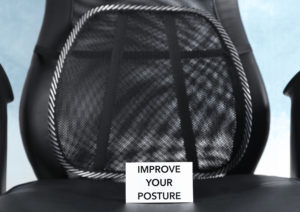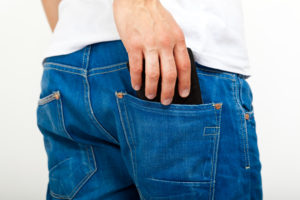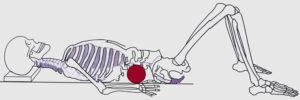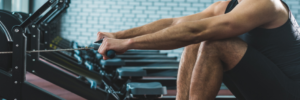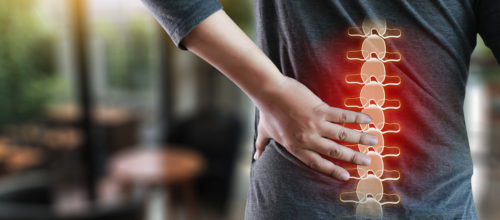
6 Non-Exercise Tips to Help Spare the Low Back
Hello everybody!
I’ve been getting messages from social media followers and new clients complaining that their low back symptoms become worse with standing, coughing or getting out of bed.
Often you will find that you can prevent symptoms from triggering by changing lifestyle habits and adjusting posture. Sometimes it may be eliminating morning exercise or correcting posture. Below you will find a list of “6” tips you can implement to help reduce stress on your low back.
1) Correct Standing Posture
People often stand in a posture that puts their lumbar erectors in a constate state of contraction – a result of leaning forward. Extending the low back till the erectors relax helps reduce stress on the low back.
If you feel your low back muscles are tight when standing, you’re perhaps leaning too far forward. Extend your low back until you feel your erectors change in tone.
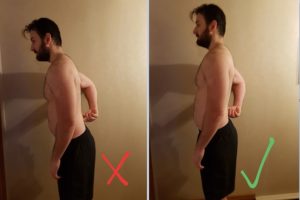
Leaning forward leaves the erector spinae in an eccentric contraction (left photo). Standing up in a neutral position (right) allows the erectors to relax and helps spare the low back. Note: You can palpate your low back to get a feel for the muscle tension during standing. You should feel less tension in your low back when in an upright position, which is an indication your erectors are relaxing.
2) A Changing Posture is the Best Posture
Stand too long – your low back will get cranky.
Sit too long – your low back will get stiff.
Lay down too long – your low back will ache.
Sitting, standing and laying down are all fundamental postures, but sticking to them for a prolonged period is not a good thing. Deformation (creep) of your tissues will occur and get worse the longer you prolong a posture – increasing the stress on tissues. Changing your posture before you start to feel stiffness or pain is critical.
If you wait till the stiffness or pain triggers – you’ve waited too long.
People are born to move – not sit, stand or lay all day.
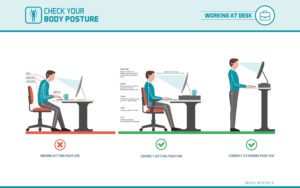
Changing between a sitting and standing position will prevent excessive deformation (creep) from taking place and allow our tissues to loosen up. A sit-stand ratio of 1 (20 mins):1 (20 mins) to 1 (20mins):3 (60mins) seems to be ideal, according to Kinesiology Professor Dr. Jack Callaghan. Image Licensed from “elenabs/depositphotos.com”
3) Extend Your Neck When You Cough or Sneeze
People with low back symptoms that trigger during coughing or sneezing may find relief by extending their neck during a sneeze or a cough. Extending the neck during a cough or sneeze will change the direction of force to an upward direction – reducing the low back demands.
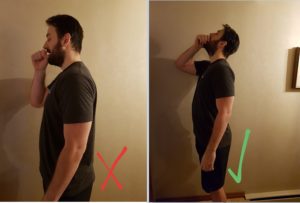
The left represents a coughing posture that increases the low back demands. The right picture represents a coughing posture that spares the low back and may help alleviate low back symptoms.
4) Minimize Early Morning Spine Bending
Research from Adams, Dolan & Hutton (1987) shows that early morning spine bending is more stressful when compared to later in the day. If you complain of morning low back pain or perhaps looking to minimize the risk of injury – minimizing spine bending 1-2 hours after waking up is critical.
Also, going for a 15-20 minute walk in the early morning can help restore normal spine mechanics and reduce morning stiffness.
5) Invest in a Lumbar Support
People sit all the time.
And some of the seats people sit in can be uncomfortable.
Sitting in an uncomfortable seat with a poor ergonomic design may increase tissue loading on the low back.
Investing in a quality backrest can perhaps make the difference of being able to sit 40 minutes without symptoms triggering versus 20 minutes in poor chair design.
6) Avoid Keeping a Wallet in Your Back Pocket
Keeping a wallet in your back pocket while you sit elevates one side of your hip and lowers the opposite side – putting you into an asymmetrical sitting posture.
Sitting with an asymmetrical sitting posture is not comfortable and puts more stress onto the low back.
Viggiani et al., (2014) conducted an experiment that examined the effect of wallet size on sitting posture, seated pressure and perceived discomfort in males and females. The researchers found that participants reported gluteal discomfort while sitting with a wallet in their back pocket and as wallet thickness increased – the greater discomfort participants reported. These findings show that sitting with a wallet in your back pocket is not a good idea if one is looking to spare the low back.
Final Thoughts
It’s never easy managing low back pain. But low back pain doesn’t have to be a life sentence for everyone. And people can manage their symptoms by being cautious with their lifestyle choices and correcting their posture. For more information on low back health – I recommend checking out Dr. Stuart McGill’s book, Back Mechanic.
Salute,
Remi
Thumbnail Image Licensed from “duiwoy/depositphotos.com”
References
Adams, M. A., Dolan, P., & Hutton, W. C. (1987). Diurnal variations in the stresses on the lumbar spine. Spine, 12(2), 130-137.
Viggiani, D., Noguchi, M., Gruevski, M. K., Carvalho, D., & Callaghan, J. (2014). The Effect of Wallet Thickness on Spine Posture, Seat Interface Pressure, and Perceived Discomfort During Sitting. IIE Transactions on Occupational Ergonomics and Human Factors, 2(2), 83-93.

